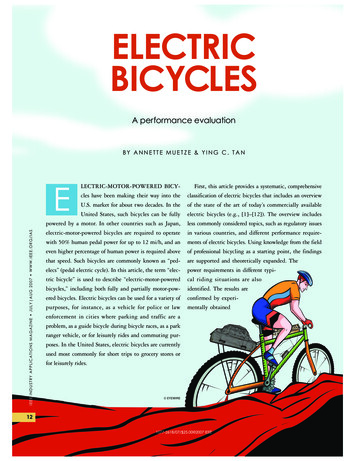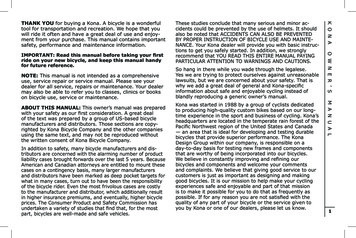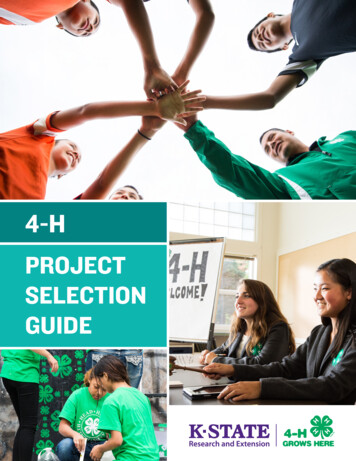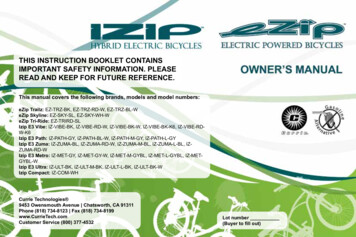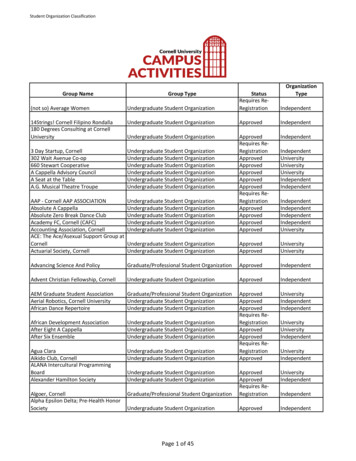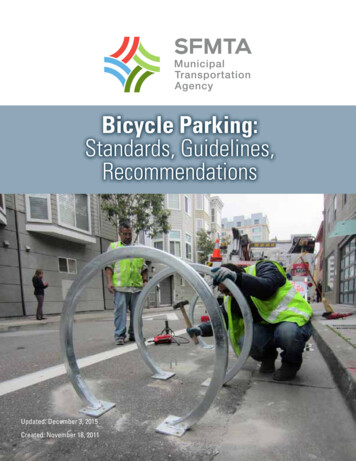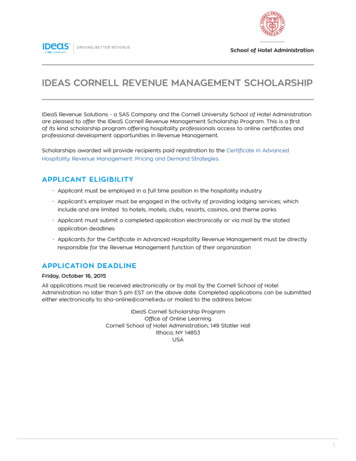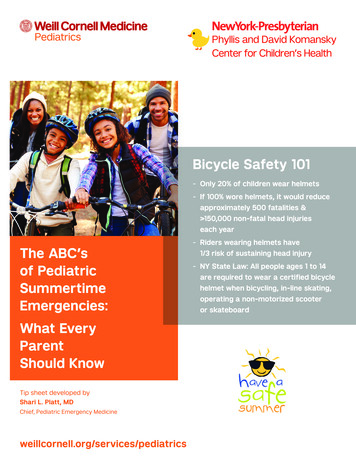
Transcription
Bicycle Safety 101-- Only 20% of children wear helmets-- If 100% wore helmets, it would reduceapproximately 500 fatalities & 150,000 non-fatal head injurieseach yearThe ABC’sof PediatricSummertimeEmergencies:What EveryParentShould KnowTip sheet developed byShari L. Platt, MDChief, Pediatric Emergency Medicineweillcornell.org/services/pediatrics-- Riders wearing helmets have1/3 risk of sustaining head injury-- NY State Law: All people ages 1 to 14are required to wear a certified bicyclehelmet when bicycling, in-line skating,operating a non-motorized scooteror skateboard
How to EncourageHelmet Use?-- Develop lifetime users-- Start early—first riding a tricycle-- Let child choose his/herown helmet-- Adults wearing helmetsThe ABC’sof PediatricSummertimeEmergencies:What EveryParentShould KnowTip sheet developed byShari L. Platt, MDChief, Pediatric Emergency reases likelihood of child use-- Discuss “head safety”with your child
Safety Tipsfor Riders:-- Make sure your helmet fits snuggly andcovers your mid-forehead-- Do not ride at dusk or nighttime-- Wear bright colorsand reflective devices-- Avoid traffic and streetswhen possible-- Always walk across streets-- Learn to stop and utilize properThe ABC’sof PediatricSummertimeEmergencies:What EveryParentShould KnowTip sheet developed byShari L. Platt, MDChief, Pediatric Emergency Medicineweillcornell.org/services/pediatricshand signals-- Obey road signs-- Check that all parts and breaksare properly functioning-- Ride safely—don’t performtricks or stunts
Scooter, In-LineSkating &Skateboard Injuries-- Moderate risk for injury,mostly fractures-- Very few considered severe,rare fatalityAAP Guidelines-- Close supervision for younger children-- Wear helmet, knee & elbow pads,wrist guards for skates-- Stay away from traffic-- Never ride at night / dusk-- Avoid gravel, rocky surfacesThe ABC’sof PediatricSummertimeEmergencies:What Every ParentShould KnowTip sheet developed byShari L. Platt, MDChief, Pediatric Emergency Medicineweillcornell.org/services/pediatrics-- Warn children about skitching(hitching a ride by holding onto a motorvehicle while riding on a skateboard,roller skates or bicycle)
Playground& Sports Injuries-- Laceration-- Broken bones (fracture)-- Head injury-- Do you see any bleeding?-- Does she complain of pain?-- Can your child move allof his/her extremities?The ABC’sof PediatricSummertimeEmergencies:What EveryParentShould KnowTip sheet developed byShari L. Platt, MDChief, Pediatric Emergency Medicineweillcornell.org/services/pediatrics-- Did your child hit her head?-- Did your child have a blackout?-- Does your child have headacheor dizziness?-- Does your child have nauseaor vomiting?
A FRACTUREis a BROKEN BONE.If your child hasa fracture:-- His/her arm is probably brokenif it is crooked or “deformed”-- What can you do if the arm is broken?-- Keep it still and do not move it-- Immobilize by securingit to something firm-- Apply ice and elevateThe ABC’sof PediatricSummertimeEmergencies:What EveryParentShould KnowTip sheet developed byShari L. Platt, MDChief, Pediatric Emergency Medicineweillcornell.org/services/pediatrics-- Call 9-1-1 if the fingers changecolor (blue) or cannot move-- Don’t give him/her anything to eat ordrink until advised by your doctor. Heor she may need strong medication forpain and sedation
Fracture: What toexpect when youarrive at the ED -- First things first—PAIN medication-- Your child will need an x-rayif he/she has -- Severe pain in one spot-- Moderate swelling-- Unable to move an extremity or walk-- If your child has a fracture -- An orthopedic surgeon may be calledThe ABC’sof PediatricSummertimeEmergencies:What EveryParentShould KnowTip sheet developed byShari L. Platt, MDChief, Pediatric Emergency Medicineweillcornell.org/services/pediatrics-- The extremity should be immobilized to»» reduce further injury and painwith motion-- A cast or splint will need to be placed-- IF the bones are not aligned the surgeonwill need to “reduce” the fracture-- Reduction means straighten the bones»» This can be very painful; to help yourchild manage pain, he/she may needsedation and pain medication
About Head Injuries-- Very common in children& adolescents-- External—bleeding outside of the skull-- Lots of veins in the scalp-- Hematoma—Swelling of scalp(looks like a “goose egg”)-- Laceration—Looks scary, lotsof blood from cut-- Internal – bleeding inside the skull-- subdural—collection of blood betweenThe ABC’sof PediatricSummertimeEmergencies:What EveryParentShould KnowTip sheet developed byShari L. Platt, MDChief, Pediatric Emergency Medicineweillcornell.org/services/pediatricsbrain and dura(membrane covering the brain)-- epidural—collection of bloodbetween skull and dura
If your child has ahead injury, call EMS(911) if your child hasthe following -- Abnormal mental status;not acting normally-- Lethargy-- Irritable-- Difficult to console-- Difficult to awaken or arouse-- Large bump or swelling on head(scalp hematoma)—less thanThe ABC’sof PediatricSummertimeEmergencies:What EveryParentShould Know2 years of age-- Loss of consciousness(“passing out” for morethan 5 seconds)-- Palpable skull fracture-- Other concerning signsor symptoms-- Vomiting-- Seizure-- Blood or clear liquid comingfrom the nose or ears-- Severe headacheTip sheet developed byShari L. Platt, MDChief, Pediatric Emergency Medicineweillcornell.org/services/pediatrics-- Dizzy, not walking normally
Andrew is playingLacrosse for highschool -- Collides with a teammate-- Falls to ground-- Unresponsive 5 mins-- Wakes and seems a bit confusedThe ABC’sof PediatricSummertimeEmergencies:What EveryParentShould KnowTip sheet developed byShari L. Platt, MDChief, Pediatric Emergency Medicineweillcornell.org/services/pediatrics-- Now is fine-- Does not remember the incident-- Has a very slight headache
Andrew has aConcussion-- Temporary loss of normal brainfunction due to trauma-- May be mild, and cause no futuredamage-- Signs of a concussion may developimmediately, or over first 24–72 hrs-- “Seeing stars”, feeling dazed, dizzy orlightheaded-- Memory loss, trouble rememberingThe ABC’sof PediatricSummertimeEmergencies:What EveryParentShould Knowright before or after the injury-- Vomiting-- Headache-- Blurry vision, sensitive to light or noise-- Confusion, slurred speech or sayingthings that don’t make sense-- Difficulty concentrating, thinking ormaking decisions-- Difficulty with coordination or balance-- Feeling anxious or irritable for noapparent reason-- May last 1–2 weeks, sometimes longer-- May last 1–2 weeks, sometimes longerTip sheet developed byShari L. Platt, MDChief, Pediatric Emergency Medicineweillcornell.org/services/pediatrics
When to go to theER if you have signsof a concussion Stop participating in the sport-- Go to the ER for further evaluation-- The ER doctor will perform a thoroughneurologic examination-- Your child will likely have a Head CTperformed (or possibly an MRI) to evaluatefor bleeding or other serious brain injury-- Your child will likely go home from the ERTreatment after the ERThe ABC’sof PediatricSummertimeEmergencies:-- Rest and light activity are needed to allowWhat EveryParentShould Know-- Repeat concussions may lead to permanentthe brain to heal-- Follow-up with a Pediatric Neurologist isrecommended-- Your child should not participate in sportsuntil cleared by a doctorbrain injury or another concussion-- Wear proper head and protective gearwhen playing sports-- Observe rules of the sport, practice goodsportsmanshipTip sheet developed byShari L. Platt, MDChief, Pediatric Emergency Medicineweillcornell.org/services/pediatrics-- Tell your coach about any prior concussion
Drowning-- Drowning is the 2nd leading causeof injury-related death in children 14 yrs.-- In 1998, 1,300 children age18 years drowned-- In children 5 years with drownrelated injuries:-- 300 children drown each year-- 2,000 are treated in the ED»» 65% are male patients-- Most common site of drowningis at a residential swimming pool-- 65% of those in their own poolThe ABC’sof PediatricSummertimeEmergencies:What EveryParentShould KnowTip sheet developed byShari L. Platt, MDChief, Pediatric Emergency Medicineweillcornell.org/services/pediatrics-- Most children are in care of parent(s)-- Nearly 50% last seen inside house-- 75% last seen in 6 mins-- Silent death—no splashing
Swimming Safety-- Teach your child to swim-- Discourage breath holdingcompetitions-- Remove toys when pool is not in use-- If a person is entrapped (hair orclothes) pry a hand between the body& the barrier to break the suction seal.Turn off the pool pump.-- Get out of the pool in thunderstormsThe ABC’sof PediatricSummertimeEmergencies:What EveryParentShould KnowTip sheet developed byShari L. Platt, MDChief, Pediatric Emergency Medicineweillcornell.org/services/pediatrics-- Never swim alone in lakes or ponds-- Pool safety barriers (fences, gates,pool covers) are not foolproof-- Never leave a child unsupervised-- Assign a designated pool watcher—especially during parties-- If your child is missing,check pool first!-- Flotation devices are not a substitutefor supervision-- Learn CPR; store rescue equipmentnear pool-- Keep Emergency phone numbersposted near pool
SunburnsSun Safety-- Unprotected exposure to UV rayscauses damage to the skin, eyes,immune suppression and can causeskin cancer-- High risk for sunburn are children withmoles, freckles, fair skin and hair,family history of skin cancer, wateractivitiesSunburn PreventionThe ABC’sof PediatricSummertimeEmergencies:What EveryParentShould Know-- Avoid strongest rays of the daybetween 10:00 am and 4:00 pm-- Protective sunscreen SPF 30 or greater-- Always use when outside, even oncloudy days-- Infants 6 months should avoid sunexposure and sunscreen-- Reapply sunscreen after swimming,sweating, & every 2–3 hrs-- Use protective clothing, hatsand sunglasses (with verified UVprotection on the labels)Tip sheet developed byShari L. Platt, MDChief, Pediatric Emergency Medicineweillcornell.org/services/pediatrics
Heat Related InjuryChildren are at a higher risk ofheat-related injury because:-- They are unable to “thermo-regulate”-- Their temperature rises 3–5x fasterthan adults-- They don’t seek shade-- They don’t seek cool water-- They don’t remove their clothingSigns of Heat Exhaustion-- Severe thirstThe ABC’sof PediatricSummertimeEmergencies:What EveryParentShould KnowTip sheet developed by-- Muscle weakness-- Nausea / vomiting-- Irritability-- Headache-- Sweating-- Cold, clammy skinSigns of Heat Stroke-- Severe, throbbing headache-- Weak, dizzy or confused-- Difficulty breathing-- Decreased responsiveness-- Little or no sweatingShari L. Platt, MD-- Flushed, hot, dry skinChief, Pediatric Emergency Medicine-- Temperature 105 Fweillcornell.org/services/pediatrics
Heat Related InjuryNever Leave Your Child (or pet)in a Parked Car-- 2008: 42 children died frombeing left in a car-- 75% are age 3 years-- Temperature rises 30 in 15–30minutes; 50 in 1 hour can reach 130 on a warm day 80o-- Cracking window open has no effectThe ABC’sof PediatricSummertimeEmergencies:What EveryParentShould KnowHow to Treat Your Child WithHeat-Related Illness-- Remove child from heat-- Remove clothing-- Place in cool (tepid) bath(do not use cold water)-- Give cool liquids-- Use a fan-- Monitor temperature-- Seek emergency care if temperaturedoes not subside or if you suspectsymptoms of heat strokeTip sheet developed byShari L. Platt, MDChief, Pediatric Emergency Medicineweillcornell.org/services/pediatrics
Insect Bites andStingsMost are benign andrequire no medicalinterventionSigns that a severe allergicreaction has occurred-- SwellingThe ABC’sof PediatricSummertimeEmergencies:What EveryParentShould Know-- Difficulty swallowing or speaking-- Chest tightness, wheezing or difficultybreathing-- Dizziness or fainting-- Abdominal pain, vomitingHow to treat?-- Remove stinger by gently scraping theskin, wash well & apply icePrevention-- Avoid bare feet in grass-- Avoid scented soaps and perfumes-- Avoid wearing bright colorsTip sheet developed byShari L. Platt, MDChief, Pediatric Emergency Medicineweillcornell.org/services/pediatrics-- Avoid playing near garbage or sodacans-- Use bug spray—do not use a spraythat contains DEET
Leading tick-bornedisease in the USLeading tick borne diseasein the US-- CT, DE, MA, MD, MN, NJ, NY, PA,RI and WI have the highest rateTypes of ticks thatcarry lyme disease-- Deer tick-- Size of a sesame seed or pencil point-- 70–80% of deer ticks are not infectedwith lyme diseaseThe ABC’sof PediatricSummertimeEmergencies:What EveryParentShould KnowTip sheet developed byShari L. Platt, MDChief, Pediatric Emergency Medicineweillcornell.org/services/pediatrics-- Borrelia BurdorfiWhat to do?-- First remove the tick, usingtweezers to grasp the tick firmlynear the child’s skin-- Pull firmly and steadily straightout, do not twist-- Do not squeeze the tick body-- Wash area with soap and water-- Do not use petroleum jelly, lighted match ornail polish to “kill” tickRisk of Lyme Diseasetransmission is low-- Risk of infection rises 48–72 hours after thetick attaches-- Tick needs time to engorge with blood
Lyme DiseaseTreatmentObserve and treat ifsymptoms developORTreat with preventativeantibiotic immediately “IF”:-- Identify adult deer tick-- Tick is attached for moreThe ABC’sof PediatricSummertimeEmergencies:What EveryParentShould Knowthan 36 hours-- Antibiotic may be used within72 hours of removal-- Doxycycline (Do not use if pregnantor in young children)-- No recommendation for treatingyoung children-- No benefit to blood testing at timeof the bite.-- Positive test will show 2–6 weeksafter infection developsSymptoms-- Erythema Chronicum Migrans (ECM)—Tip sheet developed byShari L. Platt, MDChief, Pediatric Emergency Medicineweillcornell.org/services/pediatrics80% of patients with Lyme Disease-- Target shaped rash that starts at thesite of the bite(s) within 1–4 weeks
Keep Yourself Safefrom Ticks!-- Ticks usually bite animals, such as deer or mice,but sometimes a tick can’t find an animal andbites a person instead. Ticks like to hang outin tall grassy areas and leaf piles, and attachthemselves to a person as they walk past.Then, the tick starts to feed and may stayattached to a person for several days! Whenthey are done eating, they fall off. Tick bites areusually painless and people may not notice theyhave a tick attached.The ABC’sof PediatricSummertimeEmergencies:What EveryParentShould KnowTip sheet developed byPatricia DeLaMora, MDAssociate Professor of Clinical PediatricsDivision of Pediatric Infectious Diseases505 East 70th Street, Third FloorNew York, NY 10021 646-962-6845weillcornell.org/services/pediatrics-- When hiking, wear pants, stay in the middle ofpaths as much as possible, and avoid tall grass.-- Use bug spray on exposed skin (don’t spraynear your face!)-- Check yourself carefully for ticks every day.They can be as small as a poppy seed! It maybe helpful to look at some pictures of ticksonline so you know what you’re looking for.Don’t forget to check places like between yourtoes and your ears, and have a friend checkplaces you may not be able to see very well, likethe back of your neck and your back.-- Showering every day can help washoff ticks, too.-- If you do find a tick, let your counselorknow right away.-- Some diseases that ticks carry may cause arash. if you see any rash on your body, go seethe camp nurse!
Keep YourselfLice Free!-- Lice are small bugs that hide in people’s hair andcause itching and sometimes a rash. While notdangerous, it can be uncomfortable. Lice spreadfrom person to person by catching a ride onobjects that touch hair; or by crawling from oneperson’s head to another person’s head. Lice don’thop or fly. Having lice doesn’t mean a person is“dirty” (lice actually like clean hair the best!)-- Don’t share combs, brushes, hats, helmets,headbands, hair ties, pillows. basically, if it touchesYOUR head, it shouldn’t touch anyone else’s head!The ABC’sof PediatricSummertimeEmergencies:What EveryParentShould KnowTip sheet developed byPatricia DeLaMora, MDAssociate Professor of Clinical PediatricsDivision of Pediatric Infectious Diseases505 East 70th Street, Third FloorNew York, NY 10021 646-962-6845weillcornell.org/services/pediatrics-- For girls with long hair, keeping it up in a braid or abun can make it harder for lice to crawl onto yourhair.-- If you notice your scalp is very itchy, or a rash nearyour neck or ears; go see the camp nurse!Avoid impetigo!Impetigo is an infection that can happenwhen bacteria get into a cut or scrape inthe skin.-- Shower regularly to keep skin clean-- Cover any open cuts or scrapes with a band aid-- Avoid scratching or picking at your skin-- Don’t touch other people’s skin if they have a cutor soreOther helpful tips:-- Washing your hands is one of the best way to keepgerms from spreading, so do it often; especiallybefore eating or using the bathroom-- Look at some pictures of poison ivy, oak andsumac, so you know how to spot these plants andavoid an itchy rash!
The ABC’s of Pediatric Summertime Emergencies: What Every Parent Should Know Tip sheet developed by Shari L. Platt, MD Chief, Pediatric Emergency Medicine Safety Tips for Riders:-Make sure your helmet fits snuggly and covers your mid-forehead - Do not ride at dusk or nighttime - Wear bri
